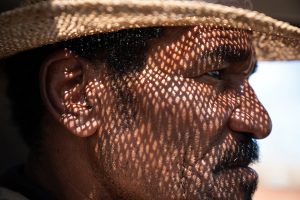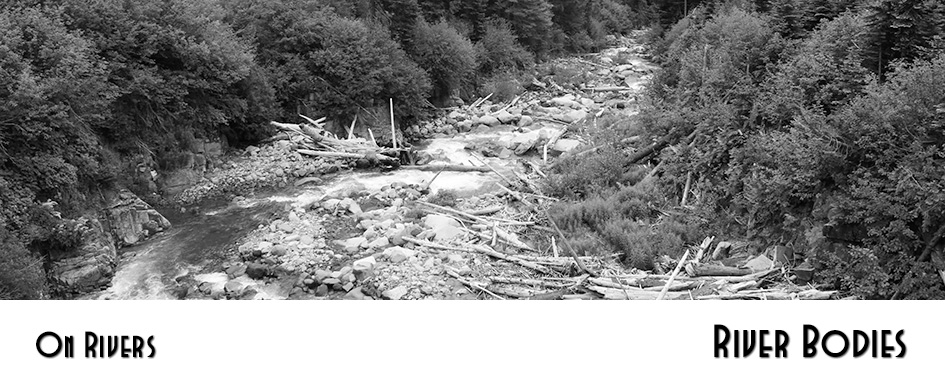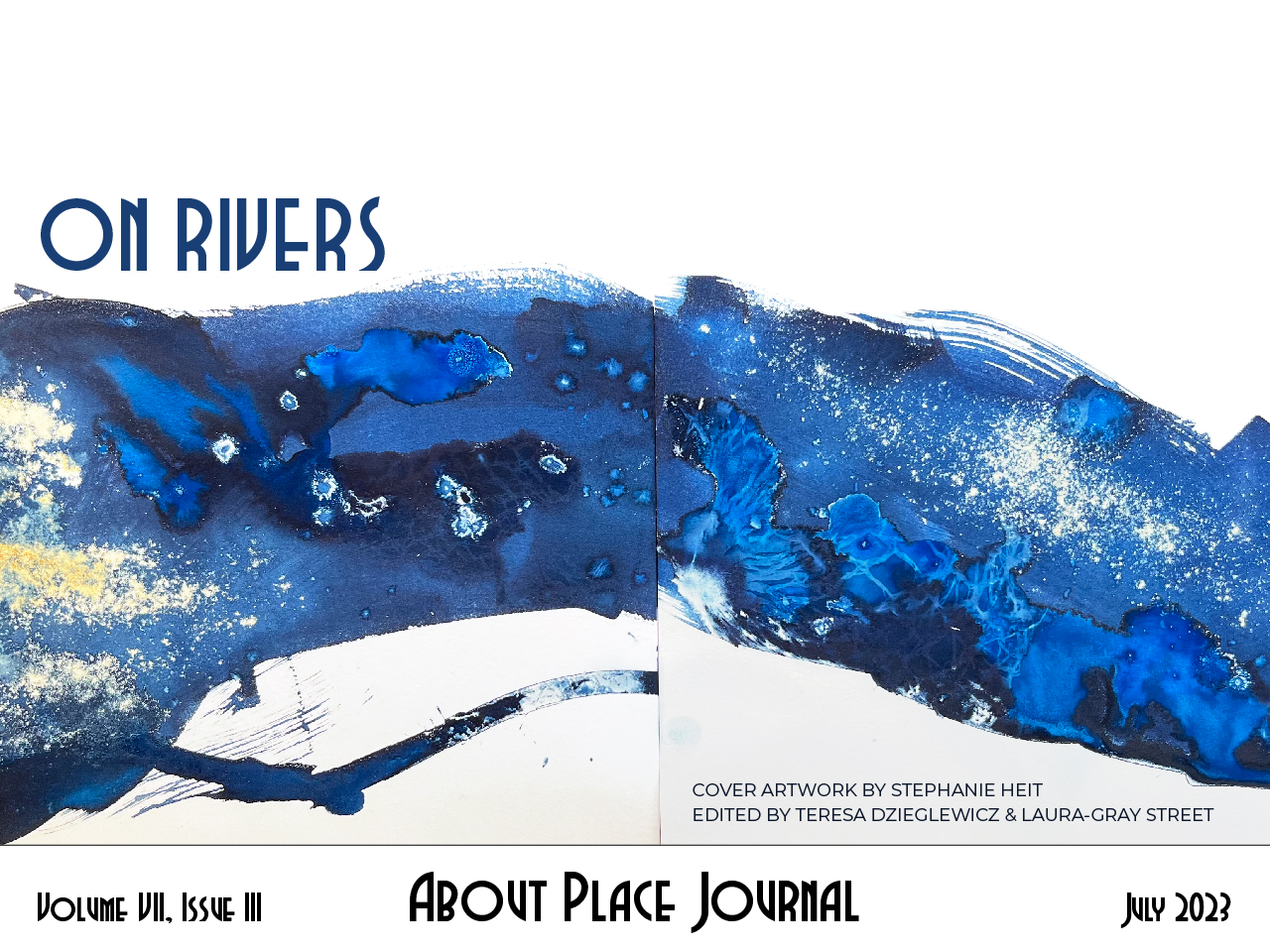 Hi, friends. I am Ann Fisher-Wirth and I am here in Clarksdale, Mississippi, with my husband Peter Wirth. We have driven over from Oxford on this chilly, slightly rainy day in early spring to interview John Ruskey, self-described river rat and owner of the Quapaw Canoe Company. We sat in the downstairs office of this big, ramshackle building right on the Sunflower River, full of driftwood, skulls and antlers found along the river, hand-crafted 29-foot-long voyageur canoes (their specialty), half-finished dugout canoes, and vivid posters depicting the course of the Mississippi River, and visited for an hour. This interview is edited from our conversation.
Hi, friends. I am Ann Fisher-Wirth and I am here in Clarksdale, Mississippi, with my husband Peter Wirth. We have driven over from Oxford on this chilly, slightly rainy day in early spring to interview John Ruskey, self-described river rat and owner of the Quapaw Canoe Company. We sat in the downstairs office of this big, ramshackle building right on the Sunflower River, full of driftwood, skulls and antlers found along the river, hand-crafted 29-foot-long voyageur canoes (their specialty), half-finished dugout canoes, and vivid posters depicting the course of the Mississippi River, and visited for an hour. This interview is edited from our conversation.
Ann: I wanted to ask you, John, to talk about your own history, what brought you here, how you ended up in Clarksdale—and then to tell us about the history of Quapaw Canoe Company.
John: The answer to the first question is simple. The river brought me here. I was born and raised in the Colorado Rockies. I’m the seventh generation of my Colorado family, and my mother, the sixth generation. I was born and raised along the headwaters of the Platte, which is a Great Plains River that starts in Colorado, flows across Nebraska, and joins the Missouri about thirty miles below Omaha. I’ve always been a river rat, and I’ve always loved water. After high school, in 1983, my best friend and I built a raft, started out above La Crosse, Wisconsin, on the Minnesota side, and set out to follow the mighty Mississippi. We were like Huck and Jim. They were our inspiration. Unlike them, we were not abused by our fathers or by slavery—but we were searching for our freedom, wanting to escape the monotony of modern America.
Ann: What brought you specifically to Clarksdale rather than some other place along the lower Mississippi?
John: Well, actually, the river did that. It deposited us on the shores of Cat Island, which is the first big island south of Memphis, just over the Mississippi state line. Not that we had any choice in the matter. The big river seemed to be intent to destroy us. We crashed on a TVA power pylon, our raft was destroyed, and the river deposited us in the shallows of the island. We were hypothermic and no way could we get to the mainland. Luckily, though, I had managed to grab the waterproof matches that my father made sure I packed away in a waterproof case. We got a fire going, and a tow pilot passing by saw the fire and called the Coast Guard. Next day, the Memphis Coast Guard came. We didn’t want to leave, but we had no choice. So my first night in Mississippi was as a muddy refugee.
I left for a while, to various places, but eventually the Blues and the river called me back. Then, years later, in 1998, I established the Quapaw Canoe Company to provide wilderness-type experiences for people on the biggest river in North America.
Ann: Please tell us more about the canoe company and about some of the activities you do.
 John: We build canoes—cypress strip canoes and dugout canoes from cottonwood, and from Louisiana bald cypress. And we paddle them on the big river in search of wild experiences in one of the most important ecosystems in North America. Our whole purpose in the company is to provide intimate experiences with nature. We take groups out, sometimes for just a few hours, sometimes for as long as a week. Once a month we offer what we call “community canoe trips,” as a way of creating new opportunities. They’re free for kids under 18, and quarter price for educators. We teach canoe carving—that dugout there is one that local kids have been working on for a couple of years. We have an apprenticeship program to teach youth about the river and its creatures, and make them care about long-term stewardship. In partnership with the Lower Mississippi River Foundation, we have a week-long summer camp for boys, and a week-long summer camp for girls. It’s mostly attended by kids from Phillips County, Arkansas, which is Helena and its environs, and Coahoma County, Mississippi. We go to the big islands along the river. It’s about a $1000-value per kid but all we ask is a $100 commitment from the participants and their families. We’ve been doing that for six or seven years, and it’s the first time there has been a summer camp along the lower Mississippi River. We’re really excited about it because one of the most meaningful things we do as guides is sharing these experiences that we have ourselves. We know the value of them. But how do you teach something like that to a kid? It doesn’t matter how many books you read or photographs you see or even movies you watch. The only method we know that really works is to offer them similar experiences.
John: We build canoes—cypress strip canoes and dugout canoes from cottonwood, and from Louisiana bald cypress. And we paddle them on the big river in search of wild experiences in one of the most important ecosystems in North America. Our whole purpose in the company is to provide intimate experiences with nature. We take groups out, sometimes for just a few hours, sometimes for as long as a week. Once a month we offer what we call “community canoe trips,” as a way of creating new opportunities. They’re free for kids under 18, and quarter price for educators. We teach canoe carving—that dugout there is one that local kids have been working on for a couple of years. We have an apprenticeship program to teach youth about the river and its creatures, and make them care about long-term stewardship. In partnership with the Lower Mississippi River Foundation, we have a week-long summer camp for boys, and a week-long summer camp for girls. It’s mostly attended by kids from Phillips County, Arkansas, which is Helena and its environs, and Coahoma County, Mississippi. We go to the big islands along the river. It’s about a $1000-value per kid but all we ask is a $100 commitment from the participants and their families. We’ve been doing that for six or seven years, and it’s the first time there has been a summer camp along the lower Mississippi River. We’re really excited about it because one of the most meaningful things we do as guides is sharing these experiences that we have ourselves. We know the value of them. But how do you teach something like that to a kid? It doesn’t matter how many books you read or photographs you see or even movies you watch. The only method we know that really works is to offer them similar experiences.
Ann: How many people work for your company? And how are the river trips organized?
 John: We have five full-time guides here, and another half-dozen part-time, and maybe a dozen or so former guides that we call on when we need help, and six shuttle drivers. Most of our trips begin and end at our base here, though we also have a base in Vicksburg and now one in Memphis. Most trips, our clients come here and we get all the gear and dry bags, pack up all the food, water, everything we need for a weekend or a week, sometimes longer, on the river. We also take six-week trips, from St. Louis to the Gulf of Mexico. We’re a custom effort, so we’ll do just about anything, customized for the client—you know, team building, church groups, Boy Scouts and Girl Scouts, wedding parties, or families scattering ashes of the dead, or honeymoons, or bachelor parties. We can serve just about anyone who wants to see the big river. So, people come here, we get everything packed up into the big canoes, then we drive to the river. From here, we might go to Helena or Tunica, or farther up by Cairo, Illinois. Then we start downstream. And wherever we end up, a week later or whenever, is where the shuttle driver meets us. Could be Vicksburg, or Saint Francisville, or Baton Rouge. We go where the water goes.
John: We have five full-time guides here, and another half-dozen part-time, and maybe a dozen or so former guides that we call on when we need help, and six shuttle drivers. Most of our trips begin and end at our base here, though we also have a base in Vicksburg and now one in Memphis. Most trips, our clients come here and we get all the gear and dry bags, pack up all the food, water, everything we need for a weekend or a week, sometimes longer, on the river. We also take six-week trips, from St. Louis to the Gulf of Mexico. We’re a custom effort, so we’ll do just about anything, customized for the client—you know, team building, church groups, Boy Scouts and Girl Scouts, wedding parties, or families scattering ashes of the dead, or honeymoons, or bachelor parties. We can serve just about anyone who wants to see the big river. So, people come here, we get everything packed up into the big canoes, then we drive to the river. From here, we might go to Helena or Tunica, or farther up by Cairo, Illinois. Then we start downstream. And wherever we end up, a week later or whenever, is where the shuttle driver meets us. Could be Vicksburg, or Saint Francisville, or Baton Rouge. We go where the water goes.
Ann and Peter: Tell us more about the river.
John: The Platte, the river where I grew up, joins the Missouri River, and the Missouri River comes in from Montana to confluence with the Mississippi just above St. Louis. The Mississippi River from Itasca, Minnesota, is 2340 miles, but if you count the Missouri-Mississippi, it’s 3710 miles, the fourth longest river in the world, after the Amazon, the Nile, and the Yangtze. Above St. Louis, the Mississippi has 27 locks and dams, but below St. Louis, it’s free-flowing, wild, and free—which is the way most river people like it. Not being transported over a river lock and dam. Not paddling across big, flat expanses of water held back by those locks. Not to mention all the cutesy ice cream shops and coffee shops and people speeding around on motorboats, and scooters or whatever you call those things. Those jet skis, I guess. The river is overpopulated with powerboats above St. Louis, but down here it’s a totally different river. It’s wild and rambunctious and chaotic and turbulent and full of unknowns and extremes, and incredible flourishes of nature at her best. And always changing and unfathomable. Qualities that make a river a river are found in abundance, in the most beautiful expressions I’ve ever experienced anywhere. Here on the Mississippi, it must be paradise.
Ann: What wildlife do you find here?
John: The Mississippi is a “long landscape,” as defined by E. O. Wilson, the Alabama biologist who studied ants and later went to Harvard. He described the long landscapes as those critical long-distance connections like Appalachia or the Rocky Mountains, those long geographic features where animals travel long distances, and the Mississippi provides this for birds and fish and other layers of creation. Paul Hartfield, for instance, is studying the migration of the river shrimp that people used to consume on the steamboats—they were popular, kind of like crawfish at the time—but we don’t know where they come from or where they travel.
It’s the flyway for 44% of migrating waterfowl, like the white pelican, and the Arctic tern, which goes to South America and summers way above the Arctic Circle. Bald eagles are making a comeback. It’s the densest population of white-tailed deer in North America. And bobcats, beavers, wild pigs. And carp. You know, everyone’s blaming the world’s problems on invasive species like wild pigs and carp—but of course, the Homo sapiens are the problem. It’s kind of exciting, when we’re paddling, especially with kids, when a carp literally jumps ten feet out of the water and over the canoe that you’re paddling.
Ann: Do they really?
John: Yeah, they’re fantastic jumpers. And we frequently see bears, and bear tracks, in our wild stretch of river. It’s the richest habitat for black bear in the middle of the country.
Ann: I wanted to ask you about the quality of the water, and if people are doing things to clean up the river.
John: Thank God for the 1972 Clean Water Act. The Mississippi was once so bad that it made people sick, and smelled bad, and was unsafe for swimming or fishing. I wasn’t here in 1970 so I can’t vouch for this personally, but in the 40 years that I’ve been on the river, I’ve seen it get cleaner than it was. You can now swim on the Lower Mississippi just about anywhere along its length, and the fish are some of the cleanest fish in the region. But in the past 10 years I’ve seen algal blooms increasing, probably due to the excess nutrients, phosphorus and nitrogen primarily. I’m talking about the lower Mississippi, and especially below Memphis. It’s much cleaner than the Ohio, which comes out of all those industrial areas of the Upper Midwest; it’s cleaner down here than the upper Mississippi in Iowa or Illinois, because of the point source pollution up there that comes from all the tributaries along the river.
Ann: I also wanted to ask you about levees, because I know there’s a whole controversial history about levees and flood control.
John: Well, the levee is an existential line that we cross every time we go out on the river. There’s life on river side of the levee, and then there’s life on the other side, and it’s like day and night. Nature has found a balance between that big powerful river and the big islands’ big forests and the creation that thrives there. And on the other side of the levee, the “dry side” of the levee where industrial-scale farming prevails, unreality begins. We have twisted and tortured and maneuvered and manipulated, and we seem to be intent on destroying everything.
 I’ve traveled all over North America and other parts of the world, too, but I’ve found closer spiritual and emotional interaction with what is the true feeling of wilderness here over the levee on this big river, this big wild river, than I’ve found anywhere else. It’s a whole, whole different feeling to be on the edge of something so big and inscrutable. It’s kind of like being on the edge of the Grand Canyon, but the difference is, you can clearly see what makes the Grand Canyon magnificent. On the Mississippi, everything is mysterious. We only know the complete life story of about a thousand animals or a thousand species. We know more about the dark side of the moon than, for instance, the bottom of the river, in this mysterious landscape.
I’ve traveled all over North America and other parts of the world, too, but I’ve found closer spiritual and emotional interaction with what is the true feeling of wilderness here over the levee on this big river, this big wild river, than I’ve found anywhere else. It’s a whole, whole different feeling to be on the edge of something so big and inscrutable. It’s kind of like being on the edge of the Grand Canyon, but the difference is, you can clearly see what makes the Grand Canyon magnificent. On the Mississippi, everything is mysterious. We only know the complete life story of about a thousand animals or a thousand species. We know more about the dark side of the moon than, for instance, the bottom of the river, in this mysterious landscape.
Peter: Eads…
John: Yeah, there’s Eads—James Buchanan Eads—the engineer who opened up the mouth of the Mississippi, and who built the first bridge across the Mississippi River at St. Louis. He explored the bottom of the river in a diving bell he invented so he could go walking on the bottom of the river. As he was studying it, he developed the system that the Army Corps of Engineers now uses to keep the channels open. Mark Twain didn’t walk on the bottom of the river, but he explored the whole length of the river as a steamboat pilot, and wrote about it in Life on the Mississippi—which is required reading for my guides. In the first twenty chapters he describes water motions, and how to read the river, more eloquently and accurately than anyone before or since.
Peter: I’ve been reading about the Atchafalaya River in south central Louisiana. Is it true that the Mississippi might change its course and flow into the Atchafalaya?
John: Absolutely. It’s just a matter of gravity. The Mississippi gets silted up. It’s dozens of feet higher than the Atchafalaya Basin, which already takes on about a third of the river’s water as it approaches the Gulf. The course of the Mississippi changes as it gets silted up—and always will.
Ann: We’re nearly out of time. Thank you so much for visiting with us. And to end with, is there anything else you’d like to tell us about the Quapaw Canoe Company, your life here in Clarksdale, and your passion for the Mississippi River?
John: We are blessed right here in this part of the country with this totally wild environment. We seek to rebalance the imbalance of humanity. The big muddy river and her flood plain create an ideal environment for re-connection to Mother Earth. We’re like beavers, we go where the water goes. In fact, we love beavers. Because beavers create wetlands. They look after their young, and make the world better. They are peaceful, sociable creatures. But we also think of ourselves as worker bees. And the river is our queen. We do whatever we can do for the benefit and health of our queen.


